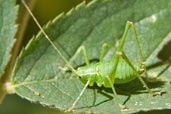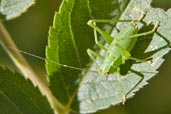
July 2009
The Speckled Bush-cricket is found in southern England and Wales. They are quite common in overgrown gardens and similar rough grassland.
Eggs are laid in bark where they overwinter hatching in May. The nymphs feed on the leaves of brambles, nettles and honeysuckle. Full maturity is reached by August and adults live until November. The male makes a faint, high-pitched chirp every few seconds.
| Previous Page | Back to Index | Next Page |